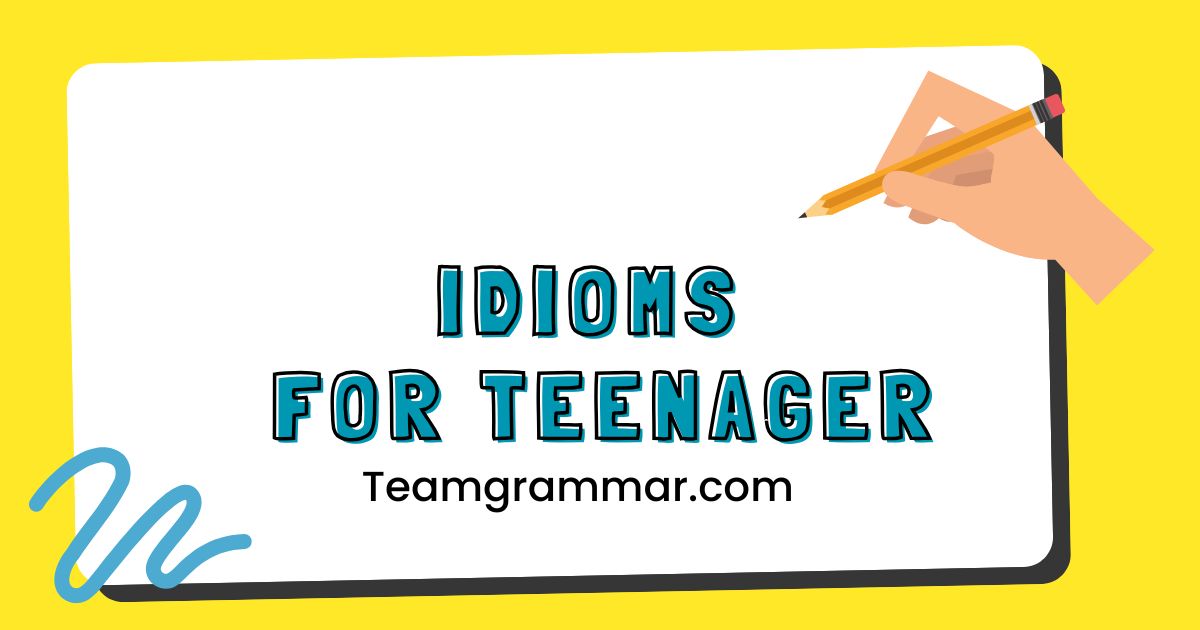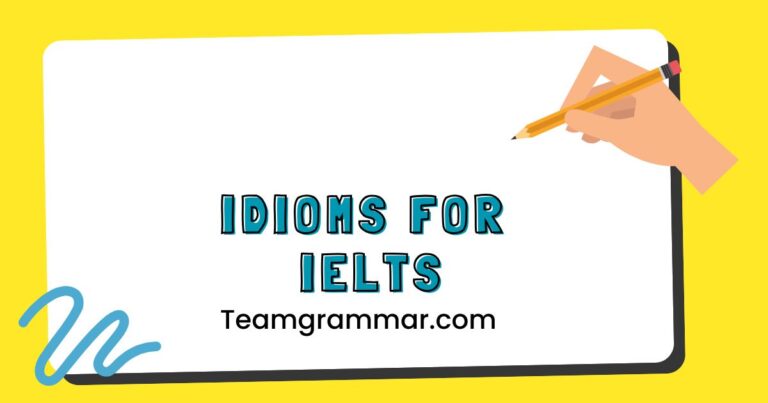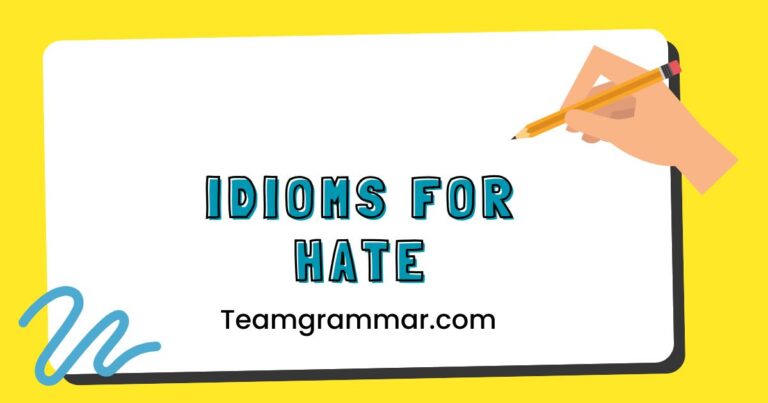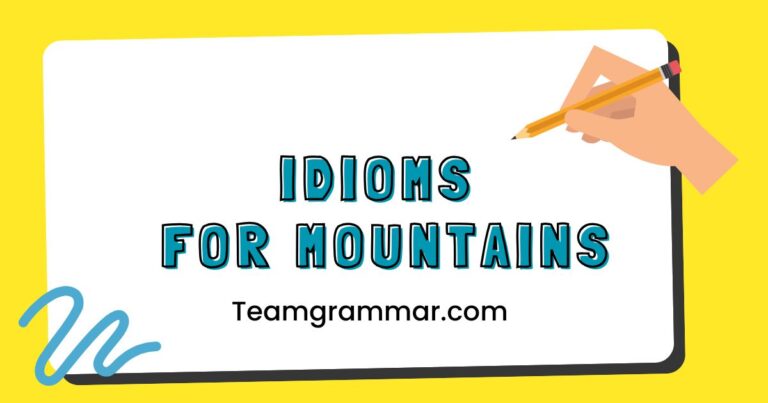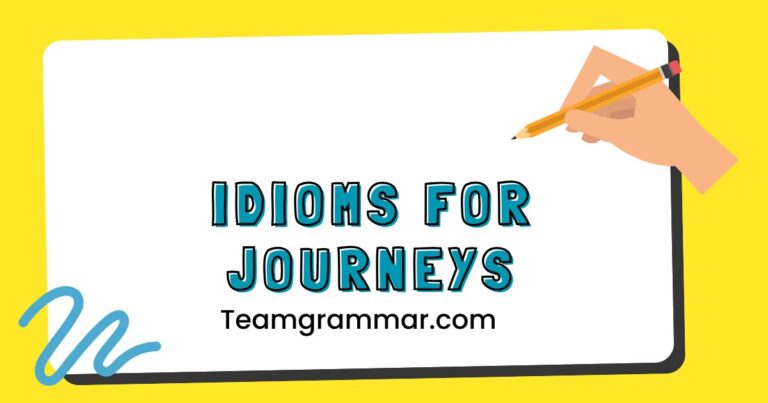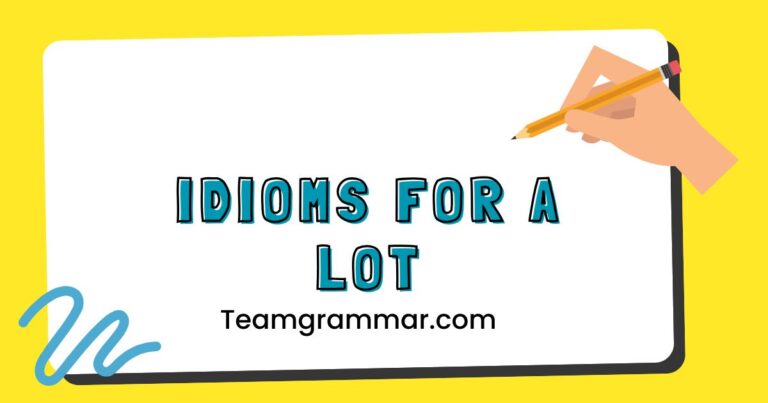49 Teen Talk: Mastering Idioms for Everyday English
Idioms are a crucial part of everyday English, especially in conversations among teenagers. Understanding idioms allows you to grasp the nuances of language, making communication more effective and relatable.
This article provides a comprehensive guide to common idioms used by teenagers, helping you understand their meanings, usage, and context. Whether you’re a student, teacher, or simply someone looking to improve your English, this guide will equip you with the knowledge to confidently navigate the world of teen slang and idioms.
Table of Contents
- Introduction
- What are Idioms?
- Structural Breakdown of Idioms
- Types of Idioms
- Examples of Idioms Used by Teenagers
- Usage Rules for Idioms
- Common Mistakes with Idioms
- Practice Exercises
- Advanced Topics in Idioms
- Frequently Asked Questions
- Conclusion
Introduction
Idioms are colorful expressions that add depth and flavor to the English language. They are especially prevalent in the everyday speech of teenagers, making it essential to understand them to fully participate in conversations and comprehend various forms of media.
This article is designed to provide a comprehensive guide to idioms commonly used by teenagers, breaking down their meanings, structures, and proper usage. By mastering these idioms, you’ll not only improve your English proficiency but also gain a deeper understanding of teen culture and communication.
This guide is suitable for learners of all levels, from beginners to advanced students. Each section includes clear explanations, examples, and practice exercises to reinforce your understanding.
Whether you’re studying for an exam, preparing for a conversation, or simply curious about teen slang, this article will serve as a valuable resource. Understanding idioms is key to unlocking a more nuanced and authentic understanding of the English language, allowing you to communicate more effectively and connect with others on a deeper level.
What are Idioms?
An idiom is a phrase or expression whose meaning cannot be understood from the literal meanings of its individual words. Instead, it has a figurative meaning that is known through common usage.
Idioms are a vital component of any language, adding color, depth, and nuance to communication. They reflect the culture and history of a language, often originating from specific events or customs.
Classification of Idioms
Idioms can be classified based on their structure and function. Some common classifications include:
- Phrasal Verbs: These are idioms that consist of a verb and a preposition or adverb (e.g., “chill out”).
- Clichés: These are overused idioms that have lost their impact (e.g., “raining cats and dogs”).
- Proverbs: These are short, well-known sayings that express a general truth or piece of advice (e.g., “a penny saved is a penny earned”).
- Metaphorical Idioms: These use metaphors to convey a figurative meaning (e.g., “break the ice”).
Function of Idioms
Idioms serve several important functions in communication:
- Adding Emphasis: They can make a statement more impactful and memorable.
- Conveying Emotion: They can express feelings and attitudes in a more vivid way.
- Establishing Rapport: Using idioms correctly can show that you are familiar with the language and culture.
- Simplifying Complex Ideas: They can sometimes express complex ideas in a concise and understandable way.
Contexts of Idioms
Idioms are used in various contexts, including:
- Informal Conversations: They are common in casual conversations with friends and family.
- Literature: They are used to add depth and character to writing.
- Movies and TV Shows: They are used to make dialogue more realistic and engaging.
- News and Media: They are used to convey information in a concise and impactful way.
Structural Breakdown of Idioms
Understanding the structure of idioms can help you recognize and interpret them more easily. Idioms often follow specific patterns and grammatical structures, although their meaning is not directly related to the literal interpretation of these structures.
Common Patterns in Idioms
Some common patterns in idioms include:
- Verb + Preposition: E.g., “look up to” (meaning to admire).
- Verb + Adverb: E.g., “give up” (meaning to quit).
- Noun + Verb: E.g., “time flies” (meaning that time passes quickly).
- Adjective + Noun: E.g., “blind date” (meaning a date with someone you haven’t met before).
Grammatical Rules and Idioms
While idioms have a fixed meaning, they can still be subject to grammatical rules. For example, the verb in an idiom must agree with the subject in number and tense.
Example:
- Correct: “He is pulling my leg.”
- Correct: “They were pulling my leg.”
- Incorrect: “He pulling my leg.”
Variations and Inflections
Some idioms can be varied or inflected to fit different contexts. However, it’s important to be cautious when changing an idiom, as it may lose its original meaning or sound awkward.
Example:
- Original: “Hit the books” (meaning to study hard).
- Variation: “I need to hit the books tonight.”
Types of Idioms
Idioms can be categorized based on their meaning and function. Here are some common types of idioms:
Phrasal Verbs
Phrasal verbs are idioms that consist of a verb and a preposition or adverb. They often have a different meaning than the individual words suggest.
Examples:
- “Hang out” (meaning to spend time with someone).
- “Look forward to” (meaning to anticipate with pleasure).
- “Get along with” (meaning to have a good relationship with someone).
Metaphorical Idioms
Metaphorical idioms use metaphors to convey a figurative meaning. They often compare one thing to another to create a vivid image or idea.
Examples:
- “Break the ice” (meaning to make people feel more comfortable).
- “A piece of cake” (meaning something that is easy).
- “Spill the beans” (meaning to reveal a secret).
Hyperbolic Idioms
Hyperbolic idioms use exaggeration to emphasize a point. They are often used for humorous effect.
Examples:
- “I’m so hungry I could eat a horse” (meaning very hungry).
- “I’ve told you a million times” (meaning many times).
- “Cry me a river” (meaning to express insincere sympathy).
Euphemistic Idioms
Euphemistic idioms are used to soften the impact of a harsh or unpleasant idea. They are often used to be polite or avoid causing offense.
Examples:
- “Pass away” (meaning to die).
- “Let go” (meaning to fire someone).
- “In the family way” (meaning pregnant).
Examples of Idioms Used by Teenagers
Teenagers use a variety of idioms in their everyday conversations. Here are some common examples, categorized for easy understanding.
These idioms reflect current trends and cultural references, making them relevant and engaging for young people.
General Teen Idioms
These idioms are commonly used in a variety of contexts and are generally understood by most teenagers.
The following table provides examples of general teen idioms, their meaning, and example sentences.
| Idiom | Meaning | Example Sentence |
|---|---|---|
| Chill out | Relax and calm down | “You need to chill out; it’s just a game.” |
| Hang out | Spend time with friends | “Let’s hang out at the mall this weekend.” |
| Hit me up | Contact me | “Hit me up later when you’re free.” |
| I’m down | I’m in; I agree | “Want to go to the movies? I’m down!” |
| No cap | No lie; for real | “That movie was amazing, no cap!” |
| Salty | Bitter; annoyed | “Why are you so salty about losing?” |
| Slay | Do something exceptionally well | “You totally slayed that presentation!” |
| Tea | Gossip | “Spill the tea; I want to know what happened.” |
| Vibe | Atmosphere; feeling | “This party has a great vibe.” |
| Woke | Aware of social issues | “He’s really woke about environmental problems.” |
| Flex | Show off | “He’s always flexing his new clothes.” |
| Ghost | To suddenly disappear from someone’s life | “I think he ghosted me after our first date.” |
| Mood | Relatable feeling or situation | “This rainy weather is such a mood.” |
| Basic | Unoriginal; mainstream | “Wearing that is so basic.” |
| Clout | Influence or popularity | “He’s just doing it for the clout.” |
| Sus | Suspicious | “That guy is acting really sus.” |
| Bet | Okay; I agree | “Can you help me with this? – Bet.” |
| Low-key | Secretly; subtly | “I’m low-key obsessed with that song.” |
| High-key | Openly; obviously | “I’m high-key excited about the concert.” |
| OTP | One True Pairing (romantic relationship) | “They are my OTP!” |
| Ship | To want two people to be in a romantic relationship | “I really ship those two characters.” |
| Savage | Brutally honest or cool | “That comeback was so savage.” |
| Big yikes | A major problem or embarrassing situation | “He wore socks with sandals? Big yikes.” |
| Finna | Going to | “I’m finna go to the store.” |
| Yeet | To throw something with force | “He yeeted the ball across the field.” |
Idioms Related to School
These idioms are often used in the context of school, homework, and academic performance.
The following table provides examples of idioms related to school, their meaning, and example sentences.
| Idiom | Meaning | Example Sentence |
|---|---|---|
| Ace a test | Get a perfect score on a test | “I studied hard and aced the test.” |
| Brain dump | Write down everything you know about a topic | “I need to do a brain dump before the exam.” |
| Cram | Study intensively for a short period of time | “I have to cram for the history test tomorrow.” |
| Cut class | Skip class | “Don’t cut class; it’s important to attend.” |
| Easy A | A class that is easy to get a good grade in | “That class is an easy A.” |
| Learn by heart | Memorize something | “You need to learn these formulas by heart.” |
| Pull an all-nighter | Stay up all night studying | “I had to pull an all-nighter to finish the project.” |
| School of hard knocks | Learning from difficult experiences | “He learned everything in the school of hard knocks.” |
| Teacher’s pet | The teacher’s favorite student | “She’s such a teacher’s pet.” |
| Bookworm | Someone who loves to read | “He’s a real bookworm; he always has a book with him.” |
| Hit the books | To study hard | “I need to hit the books if I want to pass this exam.” |
| Pass with flying colors | To pass easily and with a high score | “She passed with flying colors.” |
| Straight-A student | A student who consistently earns A’s | “He is a straight-A student.” |
| Drop out | Quit school | “He decided to drop out of high school.” |
| Make the grade | Achieve the required standard | “I need to study hard to make the grade.” |
| Copycat | Someone who copies another person’s work or ideas | “He is such a copycat.” |
| Head in the clouds | Daydreaming and not paying attention | “She always has her head in the clouds.” |
| Old school | Traditional or outdated | “That teacher’s methods are so old school.” |
| Show your work | Demonstrate the steps taken to solve a problem | “The teacher always says to show your work.” |
| Take a rain check | Reschedule for another time | “Can I take a rain check on that study session?” |
| Aced it | Did something perfectly | “I aced it on the test!” |
| Back to square one | Having to start over | “If this doesn’t work, we’re back to square one.” |
| Burn the midnight oil | Studying or working late into the night | “I have to burn the midnight oil to get this done.” |
Idioms Related to Social Life
These idioms are frequently used when discussing friendships, relationships, and social events.
The following table provides examples of idioms related to social life, their meaning, and example sentences.
| Idiom | Meaning | Example Sentence |
|---|---|---|
| BFF | Best friends forever | “We’re BFFs; we do everything together.” |
| Catch feelings | Develop romantic feelings for someone | “I think I’m starting to catch feelings for him.” |
| Double date | A date with two couples | “Let’s go on a double date this weekend.” |
| Friend zone | A situation where one person wants a romantic relationship, but the other only wants friendship | “I’m stuck in the friend zone.” |
| Get along | Have a good relationship with someone | “We get along really well.” |
| Have a crush on | Be romantically attracted to someone | “I have a crush on that girl in my class.” |
| Hit it off | Immediately get along with someone | “We hit it off right away.” |
| On the same wavelength | Thinking alike; understanding each other | “We’re always on the same wavelength.” |
| Party animal | Someone who loves to party | “He’s such a party animal.” |
| Third wheel | Someone who is with a couple and feels left out | “I felt like a third wheel on their date.” |
| Blind date | A date with someone you have never met before | “I’m going on a blind date tonight.” |
| Tie the knot | Get married | “They are planning to tie the knot next year.” |
| Lovey-dovey | Excessively affectionate | “They are so lovey-dovey.” |
| Puppy love | Young or immature love | “It’s just puppy love.” |
| Head over heels | Deeply in love | “She is head over heels for him.” |
| Break up | End a relationship | “They decided to break up.” |
| Make up | Reconcile after a fight | “They always make up quickly.” |
| Have a blast | Have a great time | “We had a blast at the party.” |
| Social butterfly | Someone who is very social and outgoing | “She is a real social butterfly.” |
| The more the merrier | The more people, the better | “The more the merrier, so invite your friends too.” |
| Get a life | Do something more interesting | “You need to get a life.” |
| Go Dutch | Split the bill | “Let’s go Dutch on dinner.” |
| A shoulder to cry on | Someone to offer support and comfort | “I am always here as a shoulder to cry on.” |
Usage Rules for Idioms
Using idioms correctly requires understanding not only their meaning but also the rules that govern their usage. Here are some important rules to keep in mind:
Contextual Appropriateness
Idioms are often informal and may not be appropriate in all situations. Consider your audience and the context before using an idiom.
In formal writing or professional settings, it’s generally best to avoid idioms.
Example:
- Appropriate in informal conversation: “Let’s hang out this weekend.”
- Inappropriate in a formal presentation: “We need to chill out and brainstorm some ideas.” (Instead, use: “We need to relax and brainstorm some ideas.”)
Grammatical Agreement
The verbs in idioms must agree with the subject in number and tense. Make sure to use the correct form of the verb to avoid grammatical errors.
Example:
- Correct: “He is pulling my leg.”
- Incorrect: “He pulling my leg.”
Word Order
The word order in idioms is usually fixed. Changing the word order can alter the meaning or make the idiom sound awkward.
Example:
- Correct: “Spill the beans.”
- Incorrect: “The beans spill.”
Exceptions and Special Cases
Some idioms have exceptions or special cases that you need to be aware of. For example, some idioms can be used in different tenses or with different prepositions.
Example:
- “Look forward to” can be used in different tenses: “I am looking forward to it,” “I looked forward to it.”
Common Mistakes with Idioms
Learners often make mistakes when using idioms, either by misunderstanding their meaning or by using them incorrectly. Here are some common mistakes to avoid:
Literal Interpretation
The most common mistake is interpreting an idiom literally. Remember that idioms have a figurative meaning that is different from the literal meaning of the words.
Example:
- Incorrect (literal interpretation): “Break a leg” (thinking you are telling someone to injure themselves).
- Correct (idiomatic meaning): “Break a leg” (meaning good luck).
Incorrect Word Order
Using the wrong word order can change the meaning of an idiom or make it sound awkward.
Example:
- Incorrect: “The beans spill.”
- Correct: “Spill the beans.”
Misusing Prepositions
Using the wrong preposition in a phrasal verb can change its meaning.
Example:
- Incorrect: “Look up on”
- Correct: “Look up to” (meaning to admire).
Overusing Idioms
Using too many idioms in a short period of time can make your speech sound unnatural or forced.
Example:
- Avoid: “I’m feeling under the weather, so I’m going to hit the hay early. It’s been a long day, and I need to recharge my batteries.”
- Better: “I’m feeling unwell, so I’m going to go to bed early. It’s been a long day, and I need to rest.”
Practice Exercises
Test your understanding of teen idioms with these practice exercises. Each exercise includes multiple-choice questions and fill-in-the-blank questions to reinforce your knowledge.
Multiple Choice Questions
Choose the correct meaning of the idiom in each sentence.
| Question | Options | Answer |
|---|---|---|
| What does “chill out” mean? | a) Get angry b) Relax c) Study hard d) Exercise | b) Relax |
| What does “hit me up” mean? | a) Punch me b) Call me c) Ignore me d) Visit me | b) Call me |
| What does “I’m down” mean? | a) I’m sad b) I’m tired c) I agree d) I’m busy | c) I agree |
| What does “no cap” mean? | a) No hat b) No lie c) No problem d) No money | b) No lie |
| What does “spill the tea” mean? | a) Make tea b) Reveal gossip c) Clean up a mess d) Drink tea | b) Reveal gossip |
| What does “ghost” mean? | a) Dress up for Halloween b) Scare someone c) Suddenly disappear d) Tell a story | c) Suddenly disappear |
| What does “flex” mean? | a) Stretch b) Exercise c) Show off d) Relax | c) Show off |
| What does “salty” mean? | a) Happy b) Angry c) Thirsty d) Hungry | b) Angry |
| What does “finna” mean? | a) Finished b) Going to c) Finding d) Forget | b) Going to |
| What does “yeet” mean? | a) To eat b) To dance c) To throw d) To sit | c) To throw |
Fill-in-the-Blank Questions
Fill in the blank with the correct idiom from the list: chill out, hit me up, I’m down, no cap, spill the tea.
| Question | Answer |
|---|---|
| “If you want to go to the party, _________.” | I’m down |
| “Just _________ and enjoy the movie.” | chill out |
| “_________ when you get home.” | Hit me up |
| “That concert was amazing, _________.” | no cap |
| “Come on, _________; I want to know what happened.” | spill the tea |
| “He is always trying to _________ to everyone.” | flex |
| “She is _________ that she didn’t get invited.” | salty |
| “I think he _________ me after the first date.” | ghosted |
| “This music is such a _________.” | vibe |
| “They _________ the test.” | aced |
Advanced Topics in Idioms
For advanced learners, understanding the nuances of idioms can further enhance their language skills. Here are some advanced topics to explore:
Historical Origins of Idioms
Many idioms have historical origins that can provide insight into their meaning and usage. Researching the etymology of idioms can be a fascinating way to deepen your understanding of the language.
Example:
- “Raining cats and dogs” is believed to have originated in 16th-century England, where heavy rain would sometimes wash dead animals down the streets.
Cultural Variations of Idioms
Idioms can vary across different cultures and regions. Some idioms may be unique to a particular country or community.
Example:
- In American English, “break a leg” means good luck. In other cultures, a different expression may be used to convey the same meaning.
Idioms in Literature
Authors often use idioms to add depth and character to their writing. Analyzing the use of idioms in literature can provide a deeper understanding of their meaning and impact.
Example:
- In Shakespeare’s plays, idioms are used to convey the emotions and attitudes of the characters.
Frequently Asked Questions
Here are some frequently asked questions about idioms that can help clarify any remaining doubts:
- What is the difference between an idiom and a proverb?
An idiom is a phrase whose meaning is not predictable from the usual meanings of its constituent elements, while a proverb is a short, well-known saying that expresses a general truth or piece of advice. - How can I learn new idioms?
Read books, watch movies, listen to music, and pay attention to conversations. When you encounter an unfamiliar idiom, look up its meaning and try to use it in your own speech or writing. - Are idioms formal or informal?
Most idioms are informal and are best used in casual conversations. However, some idioms can be used in more formal settings. - Can I change the words in an idiom?
Generally, no. Idioms have a fixed structure, and changing the words can alter the meaning or make the idiom sound awkward. - How do I know when to use an idiom?
Consider your audience and the context. If you’re not sure whether an idiom is appropriate, it’s best to avoid it. - Why are idioms important?
Idioms add color and depth to the English language. Understanding idioms can help you communicate more effectively and connect with others on a deeper level. - What is a phrasal verb?
A phrasal verb is an idiom that consists of a verb and a preposition or adverb. The meaning of a phrasal verb is often different from the individual words suggest. - How can I practice using idioms?
Try using idioms in your everyday conversations. Write sentences or stories using idioms. Ask a native speaker to correct your mistakes. - Are there any online resources for learning idioms?
Yes, there are many online resources for learning idioms, including dictionaries, websites, and apps. - How do I avoid misusing idioms?
Pay attention to the context, understand the meaning, and practice using idioms correctly. When in doubt, it’s best to avoid using an idiom.
Conclusion
Mastering idioms is an essential step in becoming fluent and confident in English. By understanding the meanings, structures, and usage rules of idioms, you can enhance your communication skills and connect with others on a deeper level.
This guide has provided a comprehensive overview of common idioms used by teenagers, along with practice exercises and tips for avoiding common mistakes. Continue to explore and practice using idioms to further improve your English proficiency and cultural understanding.
Remember that learning idioms is an ongoing process. The more you read, listen, and speak English, the more idioms you will encounter and understand.
Don’t be afraid to make mistakes; they are a natural part of the learning process. With patience and practice, you’ll be able to use idioms confidently and effectively, adding color and depth to your communication.
Embrace the challenge and enjoy
the journey of mastering the English language!

